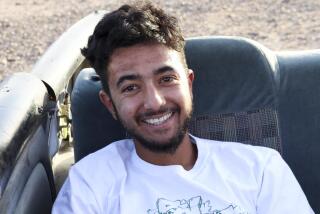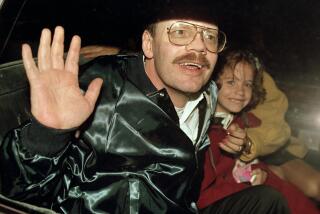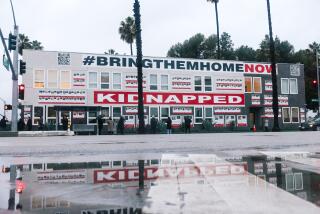Body Dumped in Beirut Identified as Buckley’s : Hostage: Former senior CIA official, kidnaped in 1984, was reported slain in 1985.
- Share via
BEIRUT — Even as hopes dimmed for the 1991 release of two Germans, the last two Westerners known to be held hostage here, Lebanese authorities on Friday positively identified remains dumped hours earlier near a Beirut airport road as those of slain U.S. hostage William Buckley.
After a two-hour autopsy at the American University of Beirut Hospital, Dr. Ahmed Harati, a pathologist and the state coroner, confirmed that Buckley’s medical and dental profiles matched those of the body, which was found wrapped in a brown blanket and bound tightly with ropes.
“Tooth fillings and the bridge matched those in Buckley’s dental record, and the scar of a broken right pelvis also matched,” Harati said.
The remains later were taken in a flag-draped coffin to the American Embassy, where officials declined comment. State Department officials here also would not discuss Buckley, who was dragged from his car at gunpoint March 16, 1984, while traveling the six blocks from the embassy to his 10th-story penthouse apartment.
But the CIA in Washington issued a statement confirming what has been reported often--that Buckley was the senior American intelligence agency official in Beirut when he was kidnaped.
The agency said that it was “carefully following reports” about the body and would make a positive identification of the remains when they are returned to the United States.
The return of Buckley’s body, the statement said, would bring to an end “the final chapter in the tragic death of this courageous and dedicated American patriot who gave his life for his country.”
Buckley, initially described as a first secretary in the U.S. Embassy’s political section here, was believed to have been an expert on terrorism with wide knowledge of CIA operations throughout the Middle East. He arrived in Beirut in the summer of 1983, charged with rebuilding American intelligence operations after the bombing of the embassy in April, 1983.
Buckley, a Medford, Mass., native, was a Boston University graduate, a lieutenant colonel in the military reserve, and a CIA veteran with experience in the Middle East, Africa, Southeast Asia, Europe and at the Directorate of Operations at CIA headquarters. He spent much of his career developing information to deter terrorist attacks on Americans in the Middle East.
Single and without dependents, Buckley--who was 55 when kidnaped--had expressed some concern about his safety in his dangerous post. His relatives also were wary.
“I would say to him, ‘Why don’t you get out of there and come home?’ ” said his sister, Maureen Moroney, of Salem, Mass. “But he’d say it was where he wanted to be. That would be just like him to stay where he was supposed to be. To me, he was probably the most patriotic human being you could imagine. His country was everything, and he would do anything for his country.”
The return of Buckley’s body means that all the Americans taken hostage in Lebanon have now been accounted for. Earlier this week, the body of Lt. Col. William R. Higgins, another slain U.S. hostage, was found, positively identified and released to the embassy.
An anonymous caller gave police directions to Buckley’s remains only hours after U.N. Secretary General Javier Perez de Cuellar said in New York that he hoped Buckley’s body would be returned by the weekend.
The caller, who said he spoke for Islamic Jihad, the group that claimed responsibility for Buckley’s abduction, told a Western news agency: “We have dumped Thursday night the body of American spy Buckley. . . . We have, thus, fulfilled our pledge. The U.N. secretary general . . . (now) has to bring about the release of our brethren in Israel.” He apparently referred to about 200 prisoners held by Israel and its militia allies in South Lebanon. Shiite Muslim kidnapers have long demanded that these captives be freed in return for the Westerners.
On Jan. 22, 1985, nine months after his abduction, Buckley appeared in a brief videotape released to a British television news agency, saying: “I am well, and my friends Benjamin Weir and Jeremy Levin are also well. We ask that our government take action for our release quickly.” Levin escaped his captors in February, 1985; Weir was released seven months later. Both said they had no contact with Buckley.
In October, 1985, Islamic Jihad released blurred photographs of what it said was Buckley’s body. It said he was slain in retaliation for an Israeli air raid on Palestine Liberation Organization headquarters in Tunisia.
But no body was produced, and U.S. officials said the photos did not prove Buckley was dead. Lebanese Shiite Muslim and Western intelligence sources said then that Buckley actually may have died earlier, possibly after having been tortured. On Jan. 20, 1987, President Bush confirmed that Buckley was dead in an oblique reference in a speech to a Washington conference on terrorism.
Freed hostage David Jacobsen has said that for a time he was held, blindfolded, in the same room with Buckley and that he believes Buckley, who was severely ill, possibly as a result of torture, died June 3, 1985. Terry A. Anderson, the last American hostage to be freed, said after his release Dec. 4 that he believed Buckley might have died in the same room with him. But he was chained and blindfolded at the time and did not see Buckley die.
Meantime, a group calling itself the Freedom Strugglers, which claims to hold the two German hostages, repeated its refusal to free the pair until the kidnapers’ demands are met. They accompanied their statement, delivered to a Western news agency, with a bizarre videotape of the German captives celebrating in front of a twinkling Christmas tree.
“We hereby thank our kidnapers for their humanitarian and good treatment,” said German aid worker Thomas Kemptner, 30, attired in a suit and shown in the tape against a poster backdrop of a lake and fir trees. He appeared to be in good health and was flanked by fellow hostage Heinrich Struebig, 50, shown reading a copy of the German magazine Der Spiegel. The two, abducted in May, 1989, ate cake, smoked cigarettes and drank toasts of fruit juice on camera.
Western diplomats said the kidnap group is under extreme pressure from Iran, Syria, Lebanon, Germany and Giandomenico Picco, Perez de Cuellar’s special hostage envoy, to free their captives unconditionally.
But in their statement, the Freedom Strugglers said it still demands, in exchange for the two Germans, freedom for two pro-Iranian Shiite Muslims serving prison terms in Germany for terrorist crimes.
“We seize this opportunity to ask Mr. (Chancellor Helmut) Kohl to give pardon to Mohammed and Abbas Hamadi,” Kemptner said.
The Germans are held by relatives of the Hamadi brothers, convicted in Germany on charges of murder, air piracy and kidnaping. Bonn has refused to exchange them for the hostages.
Times staff writer Art Pine in Washington contributed to this report.
More to Read
Sign up for Essential California
The most important California stories and recommendations in your inbox every morning.
You may occasionally receive promotional content from the Los Angeles Times.










